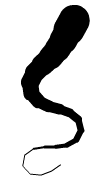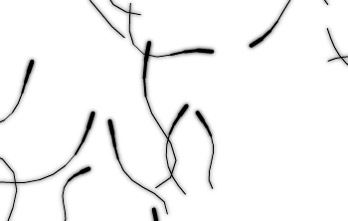
A flagellum is a lash like appendage used for locomotion. Here we have used the appendage as an organism unto itself. CLICK anywhere above to create a new organism. Each new organism is instantiated with a random set of attributes that control both its appearance and behavior. The organism is composed of a list of nodes that maintain the positions of its whip like tail. The organisms seen above have a fixed node length of 27. The first two nodes are the most important and largely contribute to the object's ability to move. The first node is the head, which determines direction of travel. The second node is the primary muscle, which oscillates behind the head in a rhythmic fashion and pushes the organism forward. The rest of the nodes move in relation to the nodes connected before them, using a simplified kinematic algorithm. |
||
 figure a. here we have a mutation that keeps the creatures skinny and numerous. |
||
The project was evolved from a ping-pong code exchange with Robert Hodgin, of Flight-404. Other computational organisms can be found here, here, and here. |
||
| jtarbell, october 2003 |


